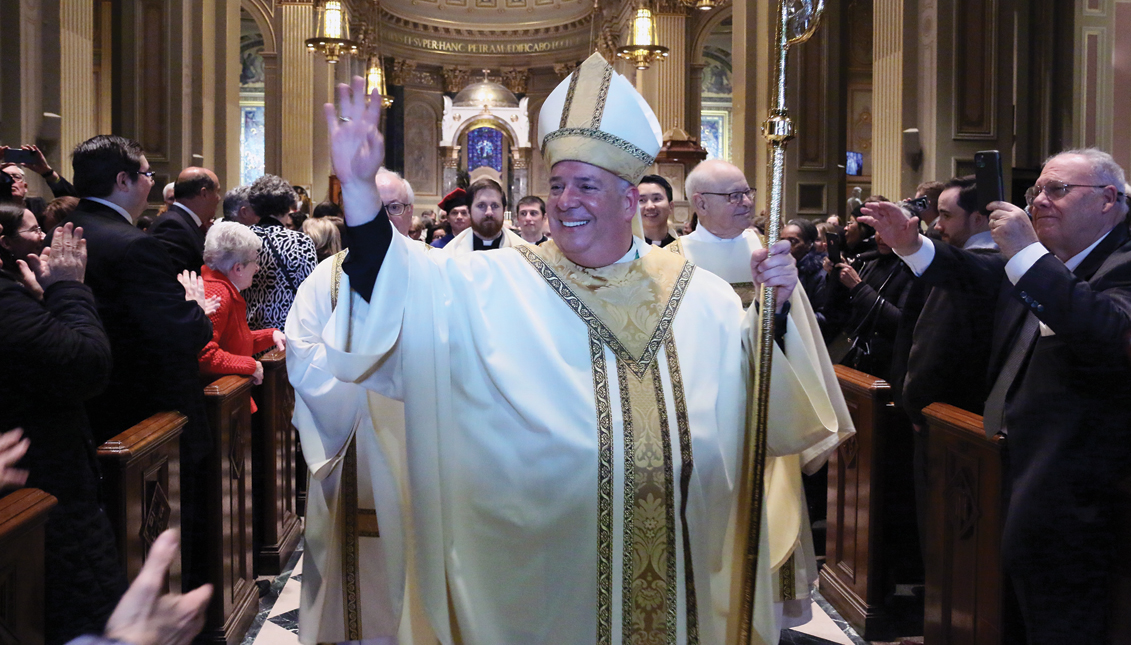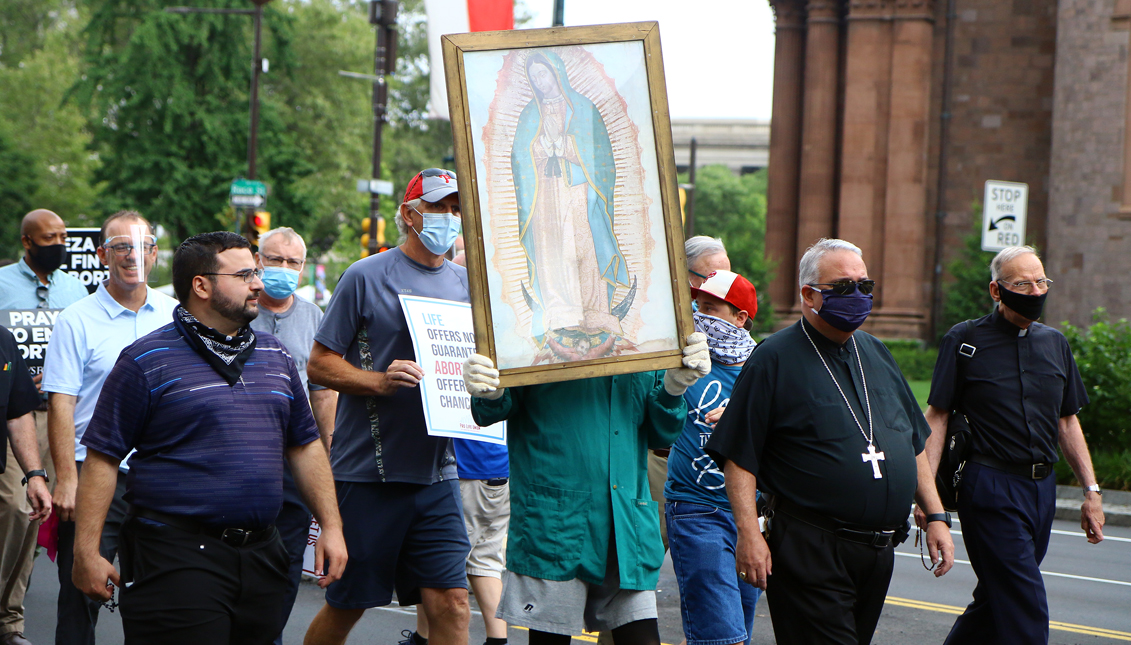
Father Nelson, Finding New Hope for Philadelphia
Archbishop Nelson Perez is the youngest leader of a major Archdiocese in the U.S. and has the time to leave a memorable mark.
When looking back at his journey to priesthood, in many ways, Philadelphia chose Nelson Perez long before he would be appointed its Archbishop by Pope Francis on Jan. 23, 2020.
“I was sent to North Philly”
Perez’s first time in the City of Brotherly Love was in the 1980s on behalf of the Church of San Juan in Puerto Rico.
“I was sent to North Philly,” he said in a recent virtual interview with AL DÍA.
Specifically, it was to the now-demolished St. Bonaventure Parish on North Ninth Street in the city’s Fairhill neighborhood.
He was sent as a seminarian and was studying to be a Salesian.
“I taught in the school and walked those streets of Cambria visiting people’s homes and talking to people in the street, and just being present,” said Perez.
Before that, he had never been to Philadelphia or knew it had the “massive” Spanish-speaking community he encountered.
Given the need at the time for Spanish-speaking members of the church to reach the community Perez met, he was asked to stay by its leaders.
“And then years later, I was ordained a priest of Philadelphia,” said Perez. “Philadelphia became my home.”
Now in his return, he says he’s spent more than half his life in Philadelphia.
But it didn’t start there.

Perez is the son of two Cuban immigrants who came to the U.S. with his older brother as refugees “looking for freedom.”
His father was a banker and was once the youngest banking executive in Cuba at 25-years-old. When the family settled in Miami, Florida, and Nelson was born, his dad sold Domino sugar door-to-door.
When the family later moved to the New York metropolitan area, the elder Perez revived his banking career, but “from scratch,” as his son described it.
“He started working at a bank in what is now Rockefeller Center,” said Perez. “He started as a teller, and eventually, he retired years later — 40 years later — as a senior vice president.”
Perez’s mother initially worked in a factory when the family arrived in Miami, but not long after, devoted herself to her family and church.
For the Archbishop, his earliest childhood memories go back to the bridge created at the church between Cuban refugees like his family.
“It was the church that brought together the Cuban community and connected them again ‘en la diaspora,’ in exile,” said Perez.
That was true of both the churches his family belonged to in Miami and when they moved north to New Jersey, specifically in the Union City, Hudson County area where another pocket of Cuban refugees had resettled en masse.
In addition to reuniting the refugees from the island throughout the 60s, 70s, and 80s, Perez also said it was the church that helped many Cubans start their new life in the U.S.
As a kid, he said he was drawn to the altar as the defining symbol in his early church days. When other kids ran and played in the pews, a young Perez was captured by its mystery and mysticism.
“The priest of my childhood, who was actually at my installation, used to say to my mom that I looked like my eyes were gonna come out of my sockets,” he said.
Despite the fascination, Perez was only enrolled in Catholic school for three years and spent the rest of his time in public school growing up.
As a result, he could not be an altar boy, but it didn’t stop Perez from appointing himself in one instance at a small parish in Union City, New Jersey.
“When the priest left the sacristy with the altar servers, I went in,” said Perez.
He put on a red robe, a cassock, and a white surplice before joining the other altar boys in the service.
Thirty-one years later, Perez said he still has the same fascination and passion for celebrating the eucharist.
“It’s still an amazing experience,” he said.

Now, as Archbishop, Perez’s mission is to rejuvenate a church that has endured decades of tragedy.
A lot of that “tragedy” is rooted in a long history of child sex abuse that has been carried out by certain members of the clergy and covered up by past leaders.
In Philadelphia, the trouble started during a 2005 grand jury investigation by then-District Attorney Lynne Abraham. It as an aftershock of the revelations in Boston’s Archdiocese that are now popularized in the movie Oscar-winning film, Spotlight
The same charges of covering up abuse, and moving offending clergymen, leveled against Archbishop Bernard Law of Boston, were also pinned against former Archbishops of Philadelphia, John Krol, and Anthony Bevilacqua.
A new grand jury investigation in 2011 revealed more cover-ups and abuse. It resulted in the first priest in the U.S. to be convicted for covering up the abuses of other clergymen. It also led to the conviction of three other priests for abuse.
In 2018, another, more significant grand jury investigation was released and detailed thousands of abuse allegations over decades across Pennsylvania’s dioceses, including Philadelphia.
The fallout from the most recent statewide revelations has been upwards of 150 lawsuits filed against Pennsylvania archdioceses, with Philadelphia being one of the most sued.
RELATED CONTENT
Perez had previously estimated that the Archdiocese of Philadelphia would pay out $130 million in settlements related to child sex abuse cases.
The financial burden brought on by the lawsuits has also caused the Archdiocese to shutter several schools and churches in recent years, and the bad press has more young people than ever turning away from church.
It’s a mountain to climb from Perez’s position, but he has the time to do it.
At 59, he is the youngest archbishop of a major archdiocese in the U.S.
For one, Perez said he wants to “establish a spirit of hope” for the church.
“It’s no secret that the Church of Philadelphia has been in great crisis in the last 20 years,” he said.
Regarding the sex abuse scandals, Perez called them the source of immense pain for those inside and outside the church.
“Painful, suffering times. A time of purging and a time of purification, but also a time of renewal,” he said. “If I, together with my brother priests and the great people of Philadelphia, could change that narrative from crisis to hope, that would be a great blessing.”
Perez also pinpointed stabilizing the church’s finances, expanding outreach to younger populations, and bringing Pope Francis’s vision of “a church that is a community of missionary disciples” to Philadelphia as his other goals for the Archdiocese under his leadership.
“It is a church that takes initiative, that takes a first step. It is a church that is engaged in the world and the life of the people around it, it’s a church that accompanies people, it is a church that is fruitful and a community that is joyful,” said Perez.

The Archbishop also intoned Pope Francis’s words when addressing the city and nation’s Latino community, which is now the majority demographic in U.S. Catholicism.
“No se queden sentados. No se ve la vida desde un balcón. Don’t observe life from a balcony, complaining about what you see, but get up and do something about it,” said Perez. “If you want the world to be a better place, then make it a better place.”
That’s a sweeping and often overwhelming proposition for people, especially in 2020, but Perez encouraged many to start small.
“Begin in your own neighborhood, begin with your neighbor. Make your world a better place,” he said.
The message of Philadelphia’s first Latino Archbishop is very much the same he heeded when first coming to the city 31 years ago. His ability to speak Spanish and connect with the community made it a better place for those living there, and many hope he can do the same as Archbishop.
When asked how he would like to be remembered, the 59-year-old stuck to his roots of going door-to-door in Fairhill.
“As a faithful priest that walked with people at different moments of their lives,” said Perez.
By doing so, he’s already developed a legacy as “Padre Nelson” in Philadelphia, coined by his former parishioners.
Now, as their Archbishop, it doesn’t change.
“For them, I’m still Padre Nelson,” said Perez, “and I will always be.”











LEAVE A COMMENT: